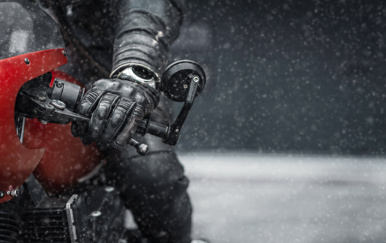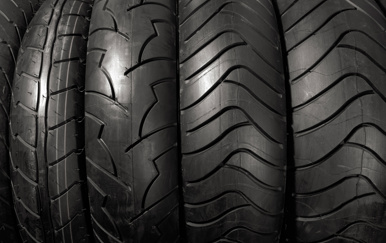Don’t let bad weather keep you from enjoying your commute on two wheels. Find out what you can do to continue to enjoy your ride - no matter the weather.
We might be biased, but we think that a scooter or a motorcycle is the best way to get to work. But if you look out of that window in the morning and see rain, fog, snow or worse, you might think you need to leave the two-wheeler at home. But you can enjoy your two-wheeler come rain or shine! All you need is a little extra kit and care.
Read on to find out exactly how to stay comfortable and protect your scooter or motorcycle in any weather.
Enjoying a comfortable commute
A commute is never improved by discomfort, so you might think you need to leave the two-wheelers at home when the weather turns bad. But rather than getting stuck in traffic in a car or, worse, public transport, there’s nothing stopping you from beating the traffic on two wheels (although we’d advise against filtering through that traffic if poor conditions!)
If you want to find out more about commuting with a two-wheeler, check out our guide to commuting on a scooter or motorcycle.
Staying warm on your motorcycle or scooter

There’s plenty of kit available that can keep you warm. Wearing multiple layers is an obvious starting point, but we also recommend investing in a good heated jacket, waistcoat or liner. Most can be powered by your bike’s battery, or come with a rechargeable battery pack that you can slip into the pocket.
For example, the Gerbing MicroWire Pro Heated Jacket Liner has over 30 metres of heated wire installed and comes with a free battery harness. A jacket liner like this one will be durable, keep your torso warm and has the added bonus of looking stylish.
However, whichever heated garment you opt for, the warmth is the essential part. A warm torso ensures your body continues to pump warm blood to all areas of your body. Therefore, it will keep your hands and feet toasty too.
Another thing that will keep your extremities warm is a decent pair of warm, winter gloves. Couple that with a set of heated grips (Oxford make some nice and affordable ones) and you’re guaranteed to keep your hands warm; vital to maintaining good control in the cold! We’d recommend some sturdy, waterproof boots too. For more advice on how to keep warm, check out our guide to winter motorcycle & scooter gear for cold weather rides.
Don’t forget about your visor. Riding in cold conditions could lead to your visor getting foggy, so ensure you spray it regularly with a good anti-fog solution. And make sure you’re not riding in the dark with a tinted visor; this will considerably reduce your visibility!
Staying dry on your motorcycle or scooter

Staying warm is one thing, but who wants to turn up to the office soaking wet? Motorcycle leathers can help you stay dry but, once they get wet, they can get weighed down and heavy to ride in.
Consider switching to alternative gear in wet weather conditions. A jacket like the Oxford Rainseal All Weather Over Jacket is fully waterproof and folds up neatly so can fit in your top box. Plus, it ensures maximum visibility too - which is never a bad thing!
The combination of wet clothes and cold air can cause a cold at best, hypothermia at worst. So make sure you’re combining wet and cold gear to keep yourself protected.
Another tip for your visor: rain can impede your visibility. Get yourself a good spray-on rain repellent, these make it hard for water droplets to stick. There are some sprays on the market that claim to be able to waterproof your visor too.
Riding your scooter or motorcycle in fog

Foggy weather might make you think twice about commuting on your two-wheeler, but you don’t need to do much to stay visible on the roads.
We recommend adding a few visibility aids to your riding gear when the weather is foggy, but there are also a few tweaks you can make to your riding that make a journey in the fog less off-putting.
1. Use anti-fog solution to keep your visor at maximum visibility and clean it before each ride.
2. Wear high visibility gear to stay seen. Even better, if it’s waterproof too.
3. Tap your break lights regularly to remind other road users of your presence.
4. Speaking of lights, make sure yours are on! It’s important to make sure all your bulbs are working as they should be, so check them often. It’s also possible to upgrade your bulbs with brighter LED versions for little expense, so this is worth looking into, though do make sure to check on compatibility for your model of bike
5. Maintain more space than usual between you and other road users, you may be vigilant, but others may not.
6. Take it slow, don’t weave and approach corners at a reduced speed. This is important if you commute regularly and are used to zipping through traffic.
7. Don’t forget about reflective road signs and cat’s eyes; they’re there to help, so keep an eye on them, especially while riding through fog to help with road placement.
Fog or mist will cause you to get wet over time, so consider some of the wet and cold weather gear we’ve mentioned too.
How to protect your ride from bad weather

It’s not just yourself that you’ll want to protect from the elements; you’ll want to protect your ride too.
The last thing you want to do is end up damaging your ride by commuting through rain or snow. Puddles, snow, sleet, mud, and even the salts used to de-ice roads can all drive moisture over and into your ride. The result? A rusty ride. But don’t worry, there are a few easy steps you can take to protect your motorcycle or scooter from bad weather.
When water isn’t cleaned off of your bike properly, it can rust and do long-term damage. In addition, the salt used to de-ice roads can wreak havoc on your exhaust pipe, rims and any exposed parts of your frame. There’s nothing you can do to stop your bike getting exposed, but regular cleaning will protect your ride from developing rust.
Here are just a few tips on how to treat a bike to protect it or clean it afterwards to prevent rust.
1. Always clean off any dirt or excess debris - This is a great habit to get into, regardless of the weather but take extra care in winter to remove any debris from your ride's exterior surfaces.
2. Apply an anti-corrosion product - These will combat any added corrosion that could occur from wet weather conditions and salty roads.
3. Pay particular attention to your bike's chain and other moving parts - Your chain (and all moving parts) will be up against more than usual during winter weather conditions. To tackle the extra salt on the roads, make sure you lube your bike's parts regularly.
For more tips on how to keep your ride pristine, check out our helpful step-by-step guide to cleaning a motorcycle. Our tips will help you to extend the life of your ride for longer.
Riding in bad weather

If it’s cold or wet enough to make you uncomfortable, it’s cold or wet enough to impact your bike’s performance. So you’ll need to make some changes to the way you ride on your way to work. These tips will help you maintain your performance while commuting in bad weather:
1. Ride cautiously, but don’t be fearful. Don’t lean into corners as much, take things a little slower, but don’t hesitate too much.
2. Avoid surfaces that could cause you to lose traction, such as manhole covers or potholes.
3. Treat other road users with caution; there’s no guarantee that they’re being as careful as you are.
4. Resist the urge to weave between traffic to warm your tyres; try stop-starting instead.
5. Brake gently and early; braking distances increase in wet weather, and braking gently helps you to avoid skidding.
If the roads are particularly wet, icy, or snowy, you might want to consider changing your tyres. Winter tyres have treads specifically designed to drain water and have better traction in wet weather conditions. We’ve written a full guide to winter tyres if you want to find out more.
*For more helpful advice on how to stay safe on your motorcycle, check out our full guide!
Should you leave your ride at home?
British weather is unpredictable, to say the least, so don’t let it put you off from your two-wheeled commute. A little extra kit and care is often all you need to keep riding whatever the weather.
That said, be sensible. Make sure you feel confident and safe when taking your ride on the road, and never ride in weather that feels like it’s outside your comfort zone. And don't forget that advanced training is available that can help you learn how to tackle poor conditions.
We all love to get our ride on the road. But, some days, you just have to leave your bike snug and warm in the garage and find some alternative transport.
One of the best ways you can protect yourself while riding is by having the correct insurance - make sure to get a motorcycle or scooter insurance direct with Lexham!






